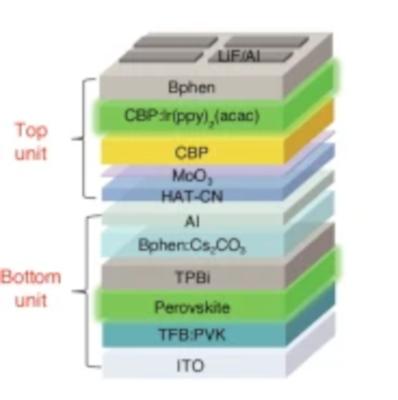Researchers at China's Shanghai University, Southern University of Science and Technology, The University of Hong Kong, Yunnan University, Beijing Institute of Technology and Japan's Yamagata University have developed a stable, efficient and high-color purity hybrid light-emitting diodes (LEDs) with a tandem structure, by combining perovskite LED and commercial organic LED technologies.
Device structure. Image credit: Light: Science & Applications
Perovskite-based LED technology can have tunable emission wavelength in visible light range as well as narrow linewidth, which makes it a promising contender among current light-emitting display technologies. However, it still suffers from severe instability driven by electric field. The research team in this work set out to tackle this challenge, by developing a method to create efficient and stable hybrid perovskite-organic light-emitting diodes.
Perovskite LED and organic LED with close photoluminescence peak were selected by the team in order to maximize photon emission without photon reabsorption and to achieve narrowed emission spectra.
By designing an efficient interconnecting layer with p-type interface doping that provides good opto-electric coupling and reduces Joule heating, the resulting green emitting hybrid LED showed a narrow linewidth of around 30 nm, a peak luminance of over 176,000 cd m−2, a maximum external quantum efficiency of over 40%, and an operational half-lifetime of over 42,000 h.
In this recent study, the team demonstrated highly efficient and stable hybrid LEDs with remarkable narrow linewidth emission constructed with a top OLED and a bottom PeLED by employing an efficient interconnecting layer (ICL) based on a structure of HAT-CN/MoO3/CBP, in which the ultra-thin MoO3 sandwiched in the organic hole inject layer and hole transport layer not only facilitates the electron transfer from CBP to HAT-CN leaving a p-type doped HTL interface that leads to significant enhancement in the capacity for charge generation, separation and transport of the ICL, but also effectively suppresses the undesired Joule heating due to the decreased resistance.
Benefiting from the proposed ICL and combining with good light outcoupling design, the hybrid LED exhibits high color purity, excellent device performance as well as significantly improved stability, reportedly representing one of the best performing tandem LEDs with ultra-high color purity to date.
This work shows the potential of combining two or more display technologies for practical applications, and the LEDs with high color purity, extremely high efficiency, and long operational lifetime would be ideal candidates to the next generation of full color displays and solid-state lighting markets.




